ACC 302 - Woolworths Group Audit: Planning, Risks, and Procedures
VerifiedAdded on 2023/06/08
|8
|1531
|251
Report
AI Summary
This report provides an analysis of the audit planning process for Woolworths Group, focusing on the financial year ended June 30, 2018. It identifies and discusses three inherent risks: high inventory levels, a volatile environment with a large network of subsidiaries, and interest rate sensitivity. The report details specific audit procedures designed to address these risks, including inventory valuation, subsidiary accounting policy evaluation, and interest rate cost verification. Furthermore, the analysis highlights areas of concern such as liquidity, solvency, and performance, suggesting corresponding audit procedures like ratio analysis and performance evaluation. The report also examines Woolworths Group's corporate governance processes and the role and composition of its audit committee, emphasizing the benefits of audit committees in fraud prevention, financial reporting oversight, and internal control enhancement. The conclusion underscores the importance of audit planning in identifying and mitigating inherent and control risks.
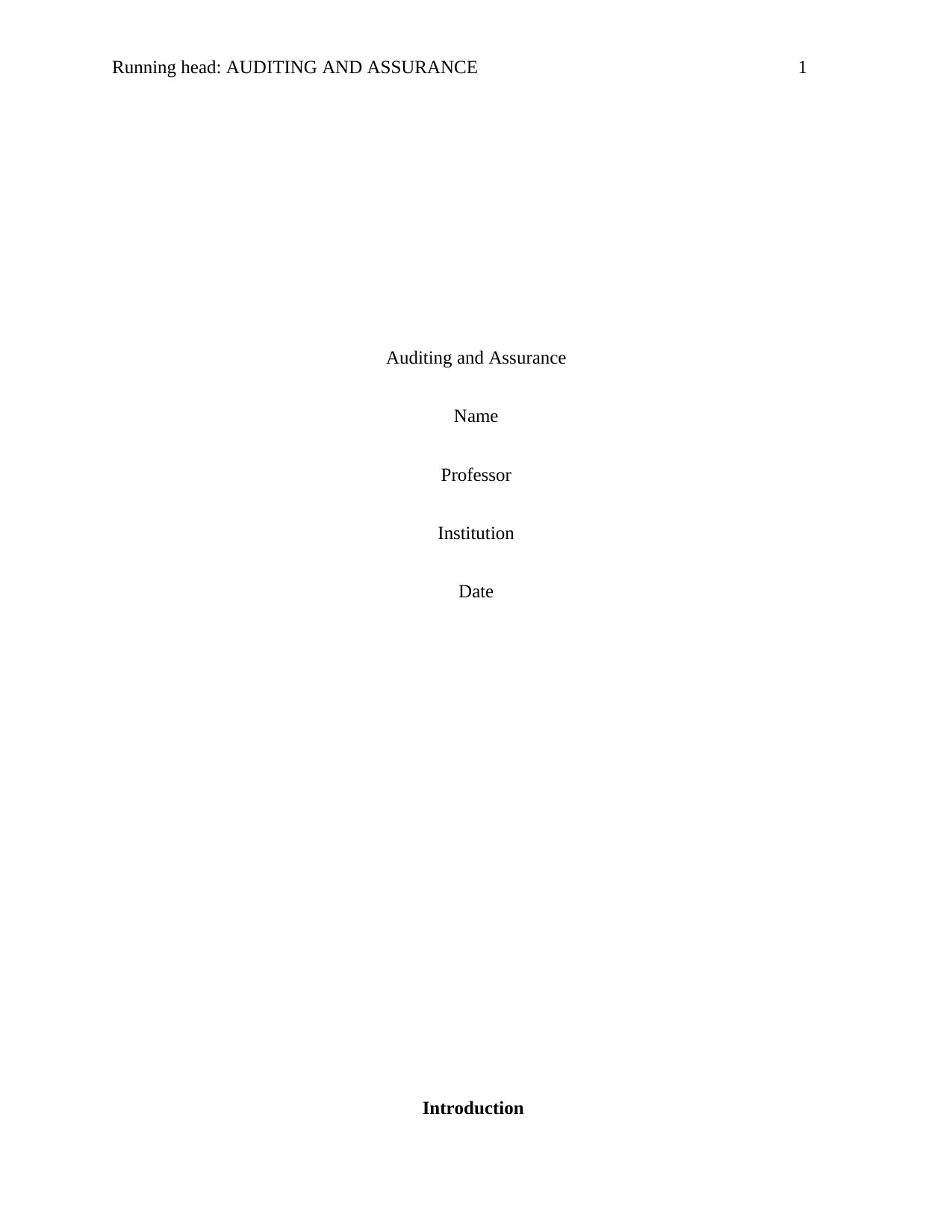
Running head: AUDITING AND ASSURANCE 1
Auditing and Assurance
Name
Professor
Institution
Date
Introduction
Auditing and Assurance
Name
Professor
Institution
Date
Introduction
Paraphrase This Document
Need a fresh take? Get an instant paraphrase of this document with our AI Paraphraser
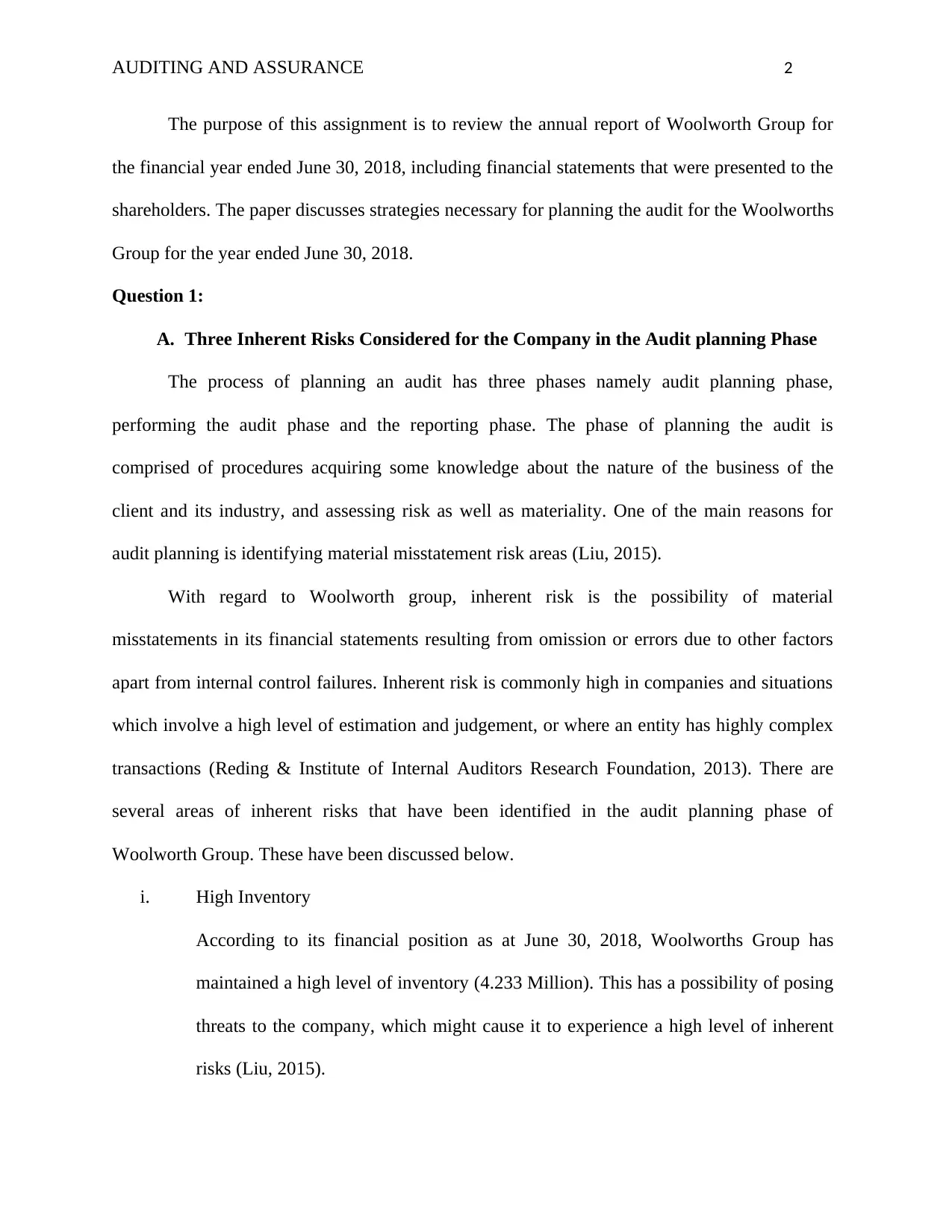
AUDITING AND ASSURANCE 2
The purpose of this assignment is to review the annual report of Woolworth Group for
the financial year ended June 30, 2018, including financial statements that were presented to the
shareholders. The paper discusses strategies necessary for planning the audit for the Woolworths
Group for the year ended June 30, 2018.
Question 1:
A. Three Inherent Risks Considered for the Company in the Audit planning Phase
The process of planning an audit has three phases namely audit planning phase,
performing the audit phase and the reporting phase. The phase of planning the audit is
comprised of procedures acquiring some knowledge about the nature of the business of the
client and its industry, and assessing risk as well as materiality. One of the main reasons for
audit planning is identifying material misstatement risk areas (Liu, 2015).
With regard to Woolworth group, inherent risk is the possibility of material
misstatements in its financial statements resulting from omission or errors due to other factors
apart from internal control failures. Inherent risk is commonly high in companies and situations
which involve a high level of estimation and judgement, or where an entity has highly complex
transactions (Reding & Institute of Internal Auditors Research Foundation, 2013). There are
several areas of inherent risks that have been identified in the audit planning phase of
Woolworth Group. These have been discussed below.
i. High Inventory
According to its financial position as at June 30, 2018, Woolworths Group has
maintained a high level of inventory (4.233 Million). This has a possibility of posing
threats to the company, which might cause it to experience a high level of inherent
risks (Liu, 2015).
The purpose of this assignment is to review the annual report of Woolworth Group for
the financial year ended June 30, 2018, including financial statements that were presented to the
shareholders. The paper discusses strategies necessary for planning the audit for the Woolworths
Group for the year ended June 30, 2018.
Question 1:
A. Three Inherent Risks Considered for the Company in the Audit planning Phase
The process of planning an audit has three phases namely audit planning phase,
performing the audit phase and the reporting phase. The phase of planning the audit is
comprised of procedures acquiring some knowledge about the nature of the business of the
client and its industry, and assessing risk as well as materiality. One of the main reasons for
audit planning is identifying material misstatement risk areas (Liu, 2015).
With regard to Woolworth group, inherent risk is the possibility of material
misstatements in its financial statements resulting from omission or errors due to other factors
apart from internal control failures. Inherent risk is commonly high in companies and situations
which involve a high level of estimation and judgement, or where an entity has highly complex
transactions (Reding & Institute of Internal Auditors Research Foundation, 2013). There are
several areas of inherent risks that have been identified in the audit planning phase of
Woolworth Group. These have been discussed below.
i. High Inventory
According to its financial position as at June 30, 2018, Woolworths Group has
maintained a high level of inventory (4.233 Million). This has a possibility of posing
threats to the company, which might cause it to experience a high level of inherent
risks (Liu, 2015).
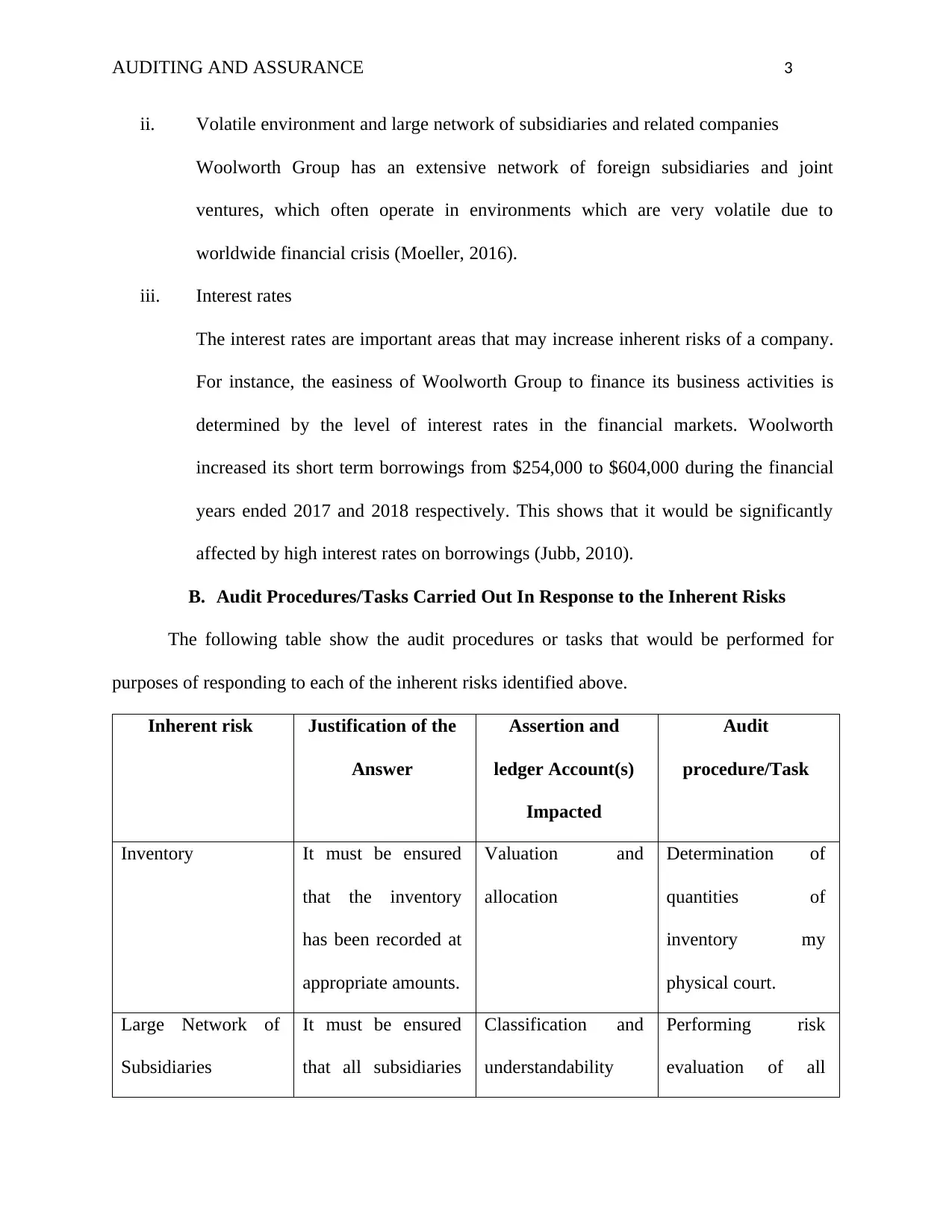
AUDITING AND ASSURANCE 3
ii. Volatile environment and large network of subsidiaries and related companies
Woolworth Group has an extensive network of foreign subsidiaries and joint
ventures, which often operate in environments which are very volatile due to
worldwide financial crisis (Moeller, 2016).
iii. Interest rates
The interest rates are important areas that may increase inherent risks of a company.
For instance, the easiness of Woolworth Group to finance its business activities is
determined by the level of interest rates in the financial markets. Woolworth
increased its short term borrowings from $254,000 to $604,000 during the financial
years ended 2017 and 2018 respectively. This shows that it would be significantly
affected by high interest rates on borrowings (Jubb, 2010).
B. Audit Procedures/Tasks Carried Out In Response to the Inherent Risks
The following table show the audit procedures or tasks that would be performed for
purposes of responding to each of the inherent risks identified above.
Inherent risk Justification of the
Answer
Assertion and
ledger Account(s)
Impacted
Audit
procedure/Task
Inventory It must be ensured
that the inventory
has been recorded at
appropriate amounts.
Valuation and
allocation
Determination of
quantities of
inventory my
physical court.
Large Network of
Subsidiaries
It must be ensured
that all subsidiaries
Classification and
understandability
Performing risk
evaluation of all
ii. Volatile environment and large network of subsidiaries and related companies
Woolworth Group has an extensive network of foreign subsidiaries and joint
ventures, which often operate in environments which are very volatile due to
worldwide financial crisis (Moeller, 2016).
iii. Interest rates
The interest rates are important areas that may increase inherent risks of a company.
For instance, the easiness of Woolworth Group to finance its business activities is
determined by the level of interest rates in the financial markets. Woolworth
increased its short term borrowings from $254,000 to $604,000 during the financial
years ended 2017 and 2018 respectively. This shows that it would be significantly
affected by high interest rates on borrowings (Jubb, 2010).
B. Audit Procedures/Tasks Carried Out In Response to the Inherent Risks
The following table show the audit procedures or tasks that would be performed for
purposes of responding to each of the inherent risks identified above.
Inherent risk Justification of the
Answer
Assertion and
ledger Account(s)
Impacted
Audit
procedure/Task
Inventory It must be ensured
that the inventory
has been recorded at
appropriate amounts.
Valuation and
allocation
Determination of
quantities of
inventory my
physical court.
Large Network of
Subsidiaries
It must be ensured
that all subsidiaries
Classification and
understandability
Performing risk
evaluation of all
⊘ This is a preview!⊘
Do you want full access?
Subscribe today to unlock all pages.

Trusted by 1+ million students worldwide
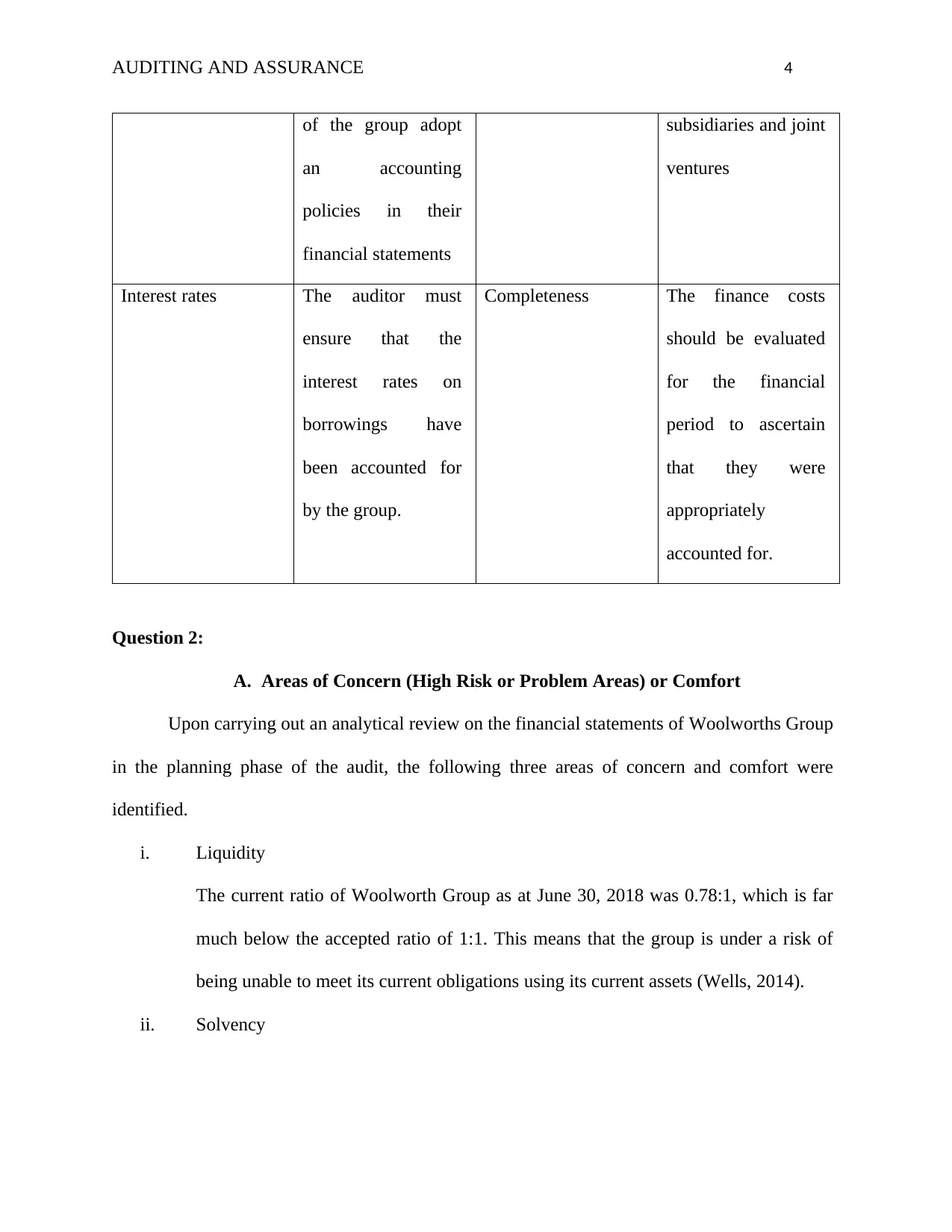
AUDITING AND ASSURANCE 4
of the group adopt
an accounting
policies in their
financial statements
subsidiaries and joint
ventures
Interest rates The auditor must
ensure that the
interest rates on
borrowings have
been accounted for
by the group.
Completeness The finance costs
should be evaluated
for the financial
period to ascertain
that they were
appropriately
accounted for.
Question 2:
A. Areas of Concern (High Risk or Problem Areas) or Comfort
Upon carrying out an analytical review on the financial statements of Woolworths Group
in the planning phase of the audit, the following three areas of concern and comfort were
identified.
i. Liquidity
The current ratio of Woolworth Group as at June 30, 2018 was 0.78:1, which is far
much below the accepted ratio of 1:1. This means that the group is under a risk of
being unable to meet its current obligations using its current assets (Wells, 2014).
ii. Solvency
of the group adopt
an accounting
policies in their
financial statements
subsidiaries and joint
ventures
Interest rates The auditor must
ensure that the
interest rates on
borrowings have
been accounted for
by the group.
Completeness The finance costs
should be evaluated
for the financial
period to ascertain
that they were
appropriately
accounted for.
Question 2:
A. Areas of Concern (High Risk or Problem Areas) or Comfort
Upon carrying out an analytical review on the financial statements of Woolworths Group
in the planning phase of the audit, the following three areas of concern and comfort were
identified.
i. Liquidity
The current ratio of Woolworth Group as at June 30, 2018 was 0.78:1, which is far
much below the accepted ratio of 1:1. This means that the group is under a risk of
being unable to meet its current obligations using its current assets (Wells, 2014).
ii. Solvency
Paraphrase This Document
Need a fresh take? Get an instant paraphrase of this document with our AI Paraphraser
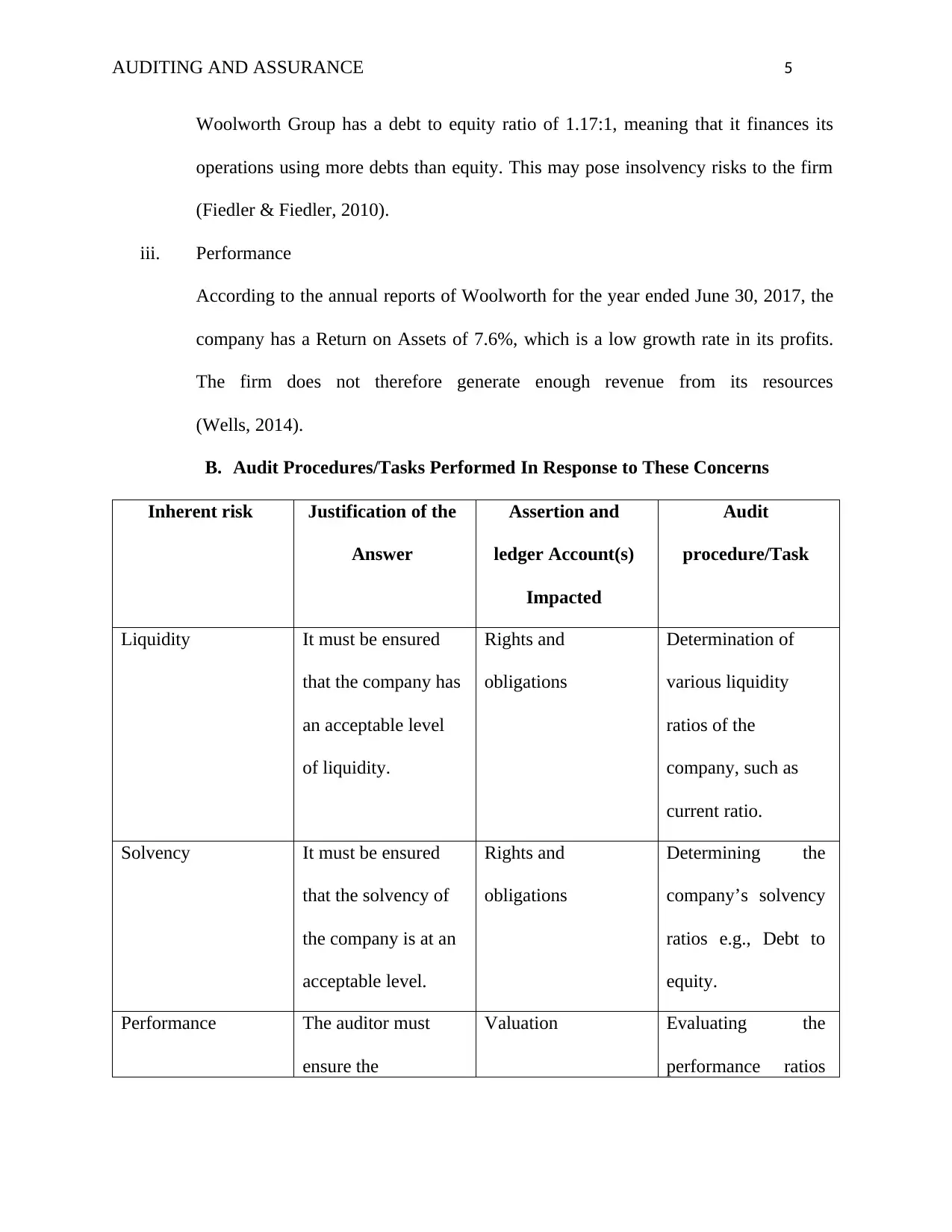
AUDITING AND ASSURANCE 5
Woolworth Group has a debt to equity ratio of 1.17:1, meaning that it finances its
operations using more debts than equity. This may pose insolvency risks to the firm
(Fiedler & Fiedler, 2010).
iii. Performance
According to the annual reports of Woolworth for the year ended June 30, 2017, the
company has a Return on Assets of 7.6%, which is a low growth rate in its profits.
The firm does not therefore generate enough revenue from its resources
(Wells, 2014).
B. Audit Procedures/Tasks Performed In Response to These Concerns
Inherent risk Justification of the
Answer
Assertion and
ledger Account(s)
Impacted
Audit
procedure/Task
Liquidity It must be ensured
that the company has
an acceptable level
of liquidity.
Rights and
obligations
Determination of
various liquidity
ratios of the
company, such as
current ratio.
Solvency It must be ensured
that the solvency of
the company is at an
acceptable level.
Rights and
obligations
Determining the
company’s solvency
ratios e.g., Debt to
equity.
Performance The auditor must
ensure the
Valuation Evaluating the
performance ratios
Woolworth Group has a debt to equity ratio of 1.17:1, meaning that it finances its
operations using more debts than equity. This may pose insolvency risks to the firm
(Fiedler & Fiedler, 2010).
iii. Performance
According to the annual reports of Woolworth for the year ended June 30, 2017, the
company has a Return on Assets of 7.6%, which is a low growth rate in its profits.
The firm does not therefore generate enough revenue from its resources
(Wells, 2014).
B. Audit Procedures/Tasks Performed In Response to These Concerns
Inherent risk Justification of the
Answer
Assertion and
ledger Account(s)
Impacted
Audit
procedure/Task
Liquidity It must be ensured
that the company has
an acceptable level
of liquidity.
Rights and
obligations
Determination of
various liquidity
ratios of the
company, such as
current ratio.
Solvency It must be ensured
that the solvency of
the company is at an
acceptable level.
Rights and
obligations
Determining the
company’s solvency
ratios e.g., Debt to
equity.
Performance The auditor must
ensure the
Valuation Evaluating the
performance ratios
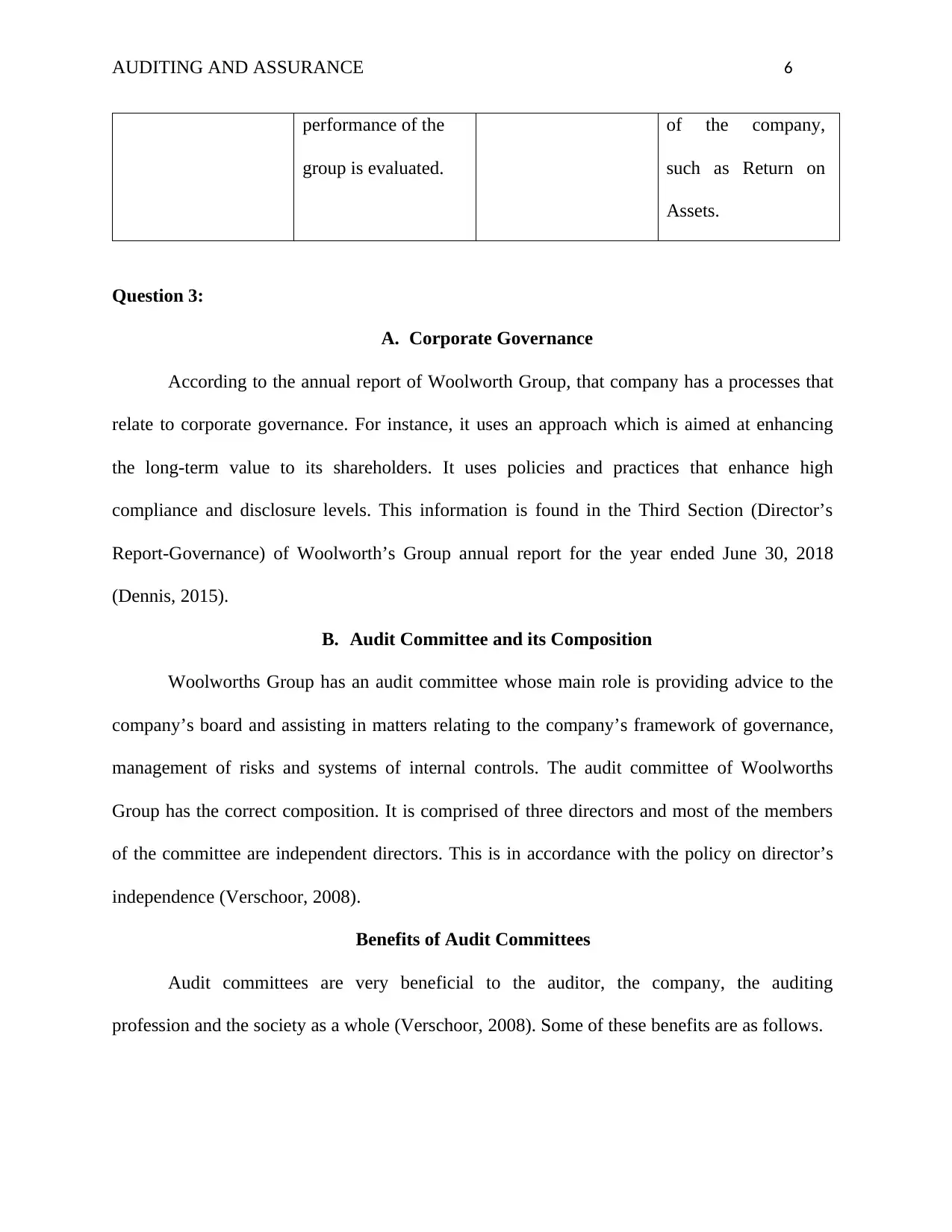
AUDITING AND ASSURANCE 6
performance of the
group is evaluated.
of the company,
such as Return on
Assets.
Question 3:
A. Corporate Governance
According to the annual report of Woolworth Group, that company has a processes that
relate to corporate governance. For instance, it uses an approach which is aimed at enhancing
the long-term value to its shareholders. It uses policies and practices that enhance high
compliance and disclosure levels. This information is found in the Third Section (Director’s
Report-Governance) of Woolworth’s Group annual report for the year ended June 30, 2018
(Dennis, 2015).
B. Audit Committee and its Composition
Woolworths Group has an audit committee whose main role is providing advice to the
company’s board and assisting in matters relating to the company’s framework of governance,
management of risks and systems of internal controls. The audit committee of Woolworths
Group has the correct composition. It is comprised of three directors and most of the members
of the committee are independent directors. This is in accordance with the policy on director’s
independence (Verschoor, 2008).
Benefits of Audit Committees
Audit committees are very beneficial to the auditor, the company, the auditing
profession and the society as a whole (Verschoor, 2008). Some of these benefits are as follows.
performance of the
group is evaluated.
of the company,
such as Return on
Assets.
Question 3:
A. Corporate Governance
According to the annual report of Woolworth Group, that company has a processes that
relate to corporate governance. For instance, it uses an approach which is aimed at enhancing
the long-term value to its shareholders. It uses policies and practices that enhance high
compliance and disclosure levels. This information is found in the Third Section (Director’s
Report-Governance) of Woolworth’s Group annual report for the year ended June 30, 2018
(Dennis, 2015).
B. Audit Committee and its Composition
Woolworths Group has an audit committee whose main role is providing advice to the
company’s board and assisting in matters relating to the company’s framework of governance,
management of risks and systems of internal controls. The audit committee of Woolworths
Group has the correct composition. It is comprised of three directors and most of the members
of the committee are independent directors. This is in accordance with the policy on director’s
independence (Verschoor, 2008).
Benefits of Audit Committees
Audit committees are very beneficial to the auditor, the company, the auditing
profession and the society as a whole (Verschoor, 2008). Some of these benefits are as follows.
⊘ This is a preview!⊘
Do you want full access?
Subscribe today to unlock all pages.

Trusted by 1+ million students worldwide
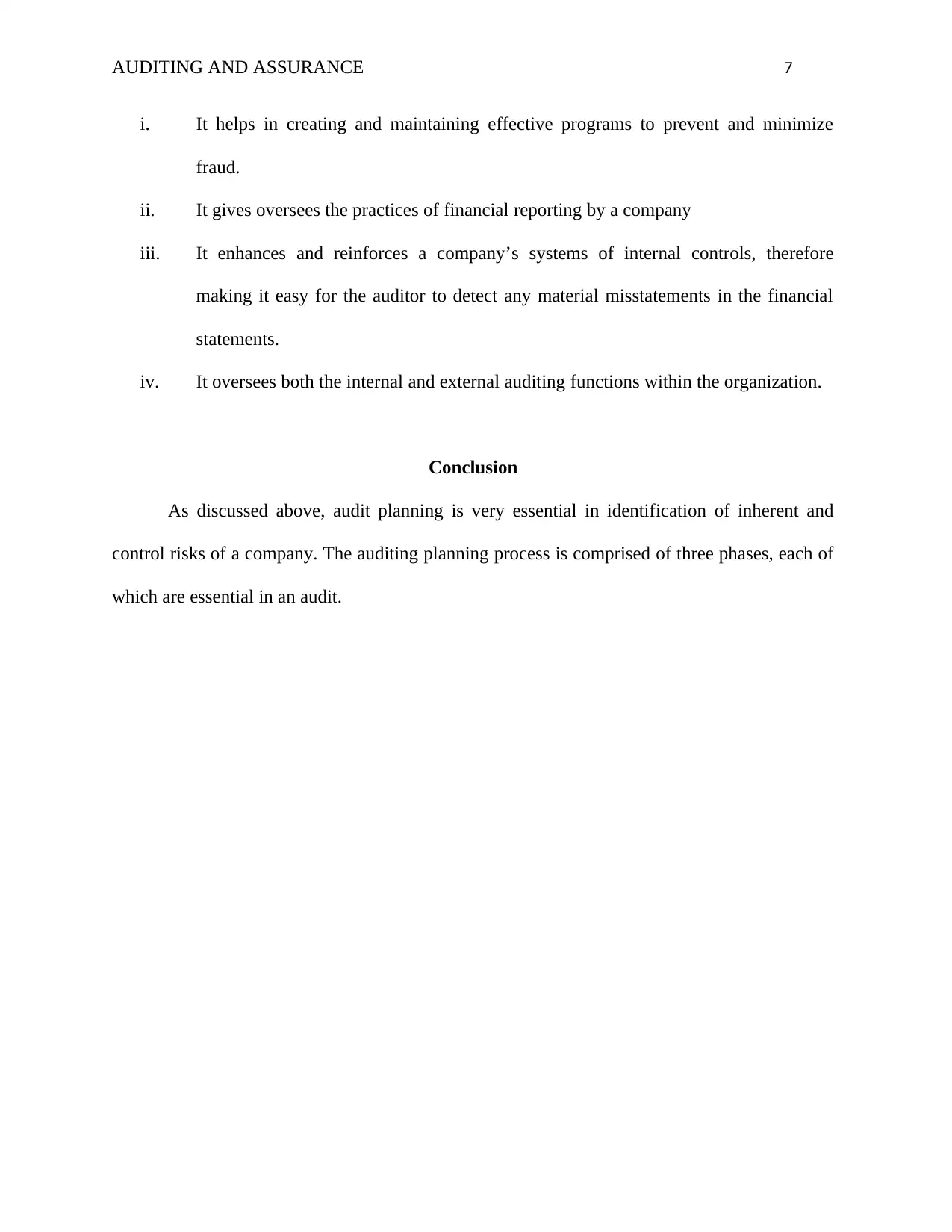
AUDITING AND ASSURANCE 7
i. It helps in creating and maintaining effective programs to prevent and minimize
fraud.
ii. It gives oversees the practices of financial reporting by a company
iii. It enhances and reinforces a company’s systems of internal controls, therefore
making it easy for the auditor to detect any material misstatements in the financial
statements.
iv. It oversees both the internal and external auditing functions within the organization.
Conclusion
As discussed above, audit planning is very essential in identification of inherent and
control risks of a company. The auditing planning process is comprised of three phases, each of
which are essential in an audit.
i. It helps in creating and maintaining effective programs to prevent and minimize
fraud.
ii. It gives oversees the practices of financial reporting by a company
iii. It enhances and reinforces a company’s systems of internal controls, therefore
making it easy for the auditor to detect any material misstatements in the financial
statements.
iv. It oversees both the internal and external auditing functions within the organization.
Conclusion
As discussed above, audit planning is very essential in identification of inherent and
control risks of a company. The auditing planning process is comprised of three phases, each of
which are essential in an audit.
Paraphrase This Document
Need a fresh take? Get an instant paraphrase of this document with our AI Paraphraser
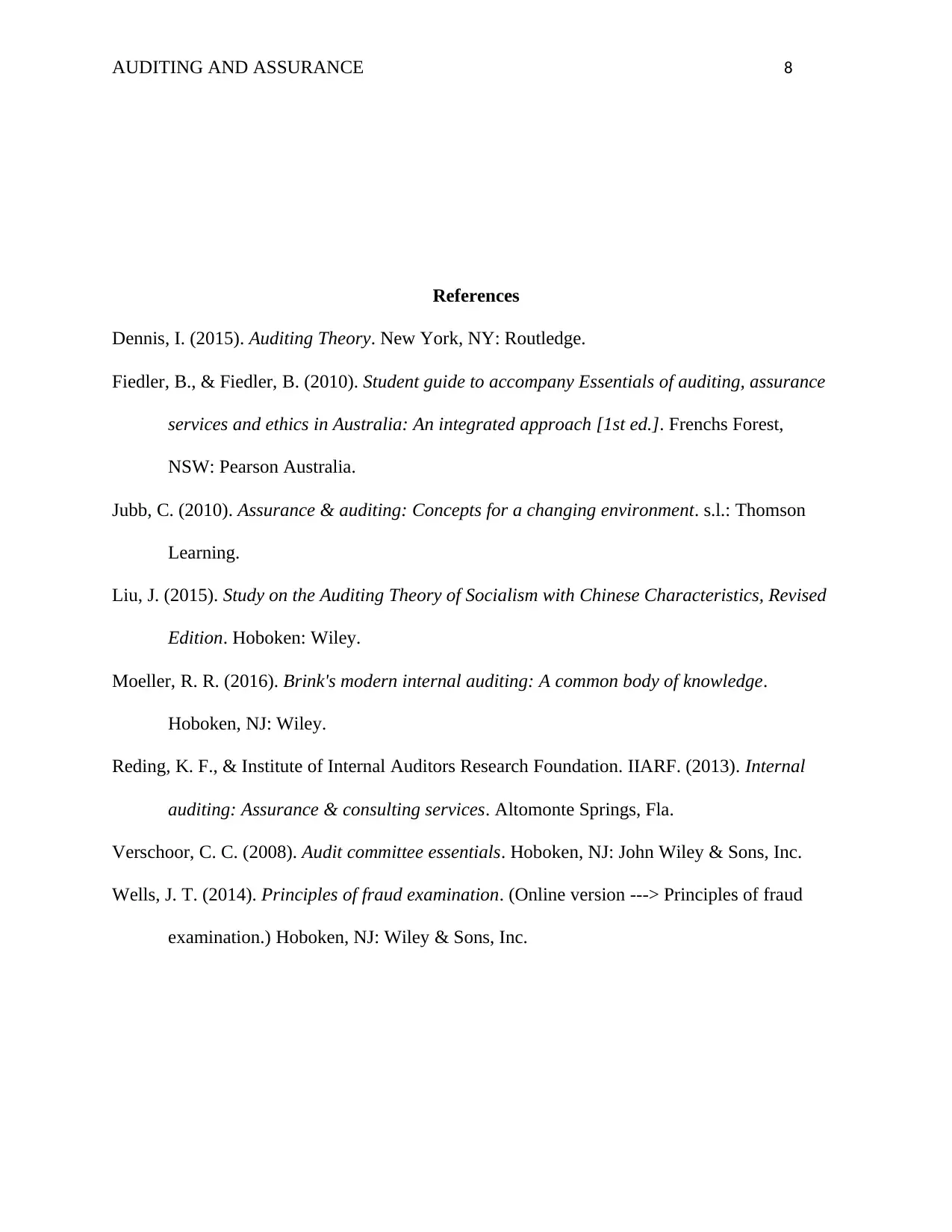
AUDITING AND ASSURANCE 8
References
Dennis, I. (2015). Auditing Theory. New York, NY: Routledge.
Fiedler, B., & Fiedler, B. (2010). Student guide to accompany Essentials of auditing, assurance
services and ethics in Australia: An integrated approach [1st ed.]. Frenchs Forest,
NSW: Pearson Australia.
Jubb, C. (2010). Assurance & auditing: Concepts for a changing environment. s.l.: Thomson
Learning.
Liu, J. (2015). Study on the Auditing Theory of Socialism with Chinese Characteristics, Revised
Edition. Hoboken: Wiley.
Moeller, R. R. (2016). Brink's modern internal auditing: A common body of knowledge.
Hoboken, NJ: Wiley.
Reding, K. F., & Institute of Internal Auditors Research Foundation. IIARF. (2013). Internal
auditing: Assurance & consulting services. Altomonte Springs, Fla.
Verschoor, C. C. (2008). Audit committee essentials. Hoboken, NJ: John Wiley & Sons, Inc.
Wells, J. T. (2014). Principles of fraud examination. (Online version ---> Principles of fraud
examination.) Hoboken, NJ: Wiley & Sons, Inc.
References
Dennis, I. (2015). Auditing Theory. New York, NY: Routledge.
Fiedler, B., & Fiedler, B. (2010). Student guide to accompany Essentials of auditing, assurance
services and ethics in Australia: An integrated approach [1st ed.]. Frenchs Forest,
NSW: Pearson Australia.
Jubb, C. (2010). Assurance & auditing: Concepts for a changing environment. s.l.: Thomson
Learning.
Liu, J. (2015). Study on the Auditing Theory of Socialism with Chinese Characteristics, Revised
Edition. Hoboken: Wiley.
Moeller, R. R. (2016). Brink's modern internal auditing: A common body of knowledge.
Hoboken, NJ: Wiley.
Reding, K. F., & Institute of Internal Auditors Research Foundation. IIARF. (2013). Internal
auditing: Assurance & consulting services. Altomonte Springs, Fla.
Verschoor, C. C. (2008). Audit committee essentials. Hoboken, NJ: John Wiley & Sons, Inc.
Wells, J. T. (2014). Principles of fraud examination. (Online version ---> Principles of fraud
examination.) Hoboken, NJ: Wiley & Sons, Inc.
1 out of 8
Related Documents
Your All-in-One AI-Powered Toolkit for Academic Success.
+13062052269
info@desklib.com
Available 24*7 on WhatsApp / Email
![[object Object]](/_next/static/media/star-bottom.7253800d.svg)
Unlock your academic potential
Copyright © 2020–2025 A2Z Services. All Rights Reserved. Developed and managed by ZUCOL.





